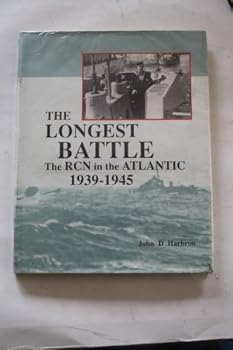Longest Battle: The Rcn in the Atlantic 1939-1945
Select Format
Select Condition 
Book Overview
The story is told in a logbook style and takes us from Downsview (Toronto) to England, France Portugal, Africa, India, Thailand and Australia in lush illustrations of familiar and exotic landscapes,... This description may be from another edition of this product.
Format:Hardcover
Language:English
ISBN:1551250020
ISBN13:9781551250021
Release Date:January 1993
Publisher:Vanwell Publishing Ltd.
Length:132 Pages
Weight:1.55 lbs.
Dimensions:11.5" x 0.5" x 9.0"
Customer Reviews
1 rating
Ready, Aye Ready
Published by Thriftbooks.com User , 23 years ago
Given the reduced and somewhat rattletrap state of the modern no-longer-royal Canadian navy (now laboring under the bureaucratic shroud, 'Canadian Forces Maritime Command'), John D. Harbron's story of the RCN in the Second World War is an especially educational and evocative one.The story is nothing less than one of transformation. From its 'miniscule' starting point in 1939, the RCN was by 1945 the fourth largest navy in the world, with nearly 500 ships in commission. Almost all of those had been constructed during the war in Canadian shipyards, which also were able to turn out more than 400 critically needed merchant vessels for the North Atlantic convoys. Thousands of men and women who had no experience with the sea were turned into a disciplined and efficient fighting force, building a war record of which any nation could be proud.While not intended as a comprehensive history of fleet actions, 'The Longest Battle' nevertheless tells its story effectively. In the battle of the North Atlantic, German U-boats and Canadian ships squared off without ceasing from the start of the war to the final surrender -- hence the title, 'The Longest Battle.' The fighting often surged into Canada's own waters, sometimes as far west as the St Lawrence River itself.Harbron also gives us a brief but descriptive look at the various classes of Canadian warships, the growth of the merchant navy, the history of the Wrens (officially, Women's Royal Canadian Naval Service, or WRCNS), and, interestingly, a chapter about the RCN's antagonists, the U-boats and their crews. There is also a touching section telling the stories of two RCN families and their wartime experiences.Harbron also argues that the transformation of the RCN had a lasting effect on Canada's society. In the 1940s, Canada was far more British, culturally and ethnically, than it is today. He writes, 'Canadian nationalism was reborn in the wartime mess decks of the Royal Canadian Navy. In September 1939 the tiny Canadian navy went to war as a pliant auxiliary of the [British] Royal Navy. In May 1945, it emerged at the peace as a full-blown, confident Canadian national institution in which Canadians from all our geographic regions and many ethnic communities had been drawn together in a common cause' (p. 19).A book this size can only skim the surface of all there is to tell about its subject. But packed as it is with great photos and informed, personal writing, it does credit to the ships, their crews, and the navy that at a time of crisis lived up to its stirring motto, 'Ready, Aye Ready.'






